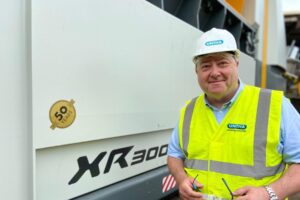Airborne dust is often dismissed as an unavoidable byproduct of waste processing, but its impact can be severe. From health risks to fire hazards, managing dust is critical in industrial waste operations. Gary Moore, Sales Director at industrial shredding specialist UNTHA UK explores how slow-speed shredding technology can provide a proactive solution to this challenge.
The Hidden Dangers of Dust in Waste Facilities
While bulky waste streams like automotive parts or large appliances often steal the spotlight, one of the most complex byproducts of waste processing is dust. Generated during sorting, shredding, crushing, and transportation, fine particulates can carry toxic chemicals and hazardous substances. Once airborne, these particles can be inhaled, absorbed, or ingested, posing significant health risks such as asthma, chronic obstructive pulmonary disease (COPD), heart disease, and even cancer.
Beyond health concerns, dust is highly flammable, increasing the risk of fires in industrial settings where sparks from equipment are common. This makes dust management a crucial aspect of workplace safety and operational efficiency.
Staying Compliant with Workplace Health & Safety Standards
Recognising the risks, regulatory bodies enforce strict limits on airborne contaminants. In Australia, workplace exposure limits (WELs) for wood dust and other hazardous particulates are governed by Safe Work Australia’s regulations. Non-compliance can lead to significant consequences, including heavy fines or operational shutdowns.
To mitigate these risks, waste operators should implement effective dust extraction systems, avoid practices that disturb hazardous particles, enforce appropriate personal protective equipment (PPE) use, and conduct regular health surveillance. However, the most effective strategy is to control dust at the source—and this is where slow-speed shredding technology excels.

The Power of Slow-Speed Shredding
UNTHA’s slow-speed shredders, available through FOCUS enviro, use high-torque, low-speed technology to process bulky materials efficiently while minimising dust generation. Slow speed high torque shredders can significantly reduce airborne particulates, creating a cleaner working environment with fewer health risks.
Key benefits of slow-speed shredding technology include:
- Lower dust emissions – Minimised fine particle production during shredding.
- Fire risk reduction – Advanced fire suppression technology and reduced risk of spark generation.
- Enhanced safety features – Auto-stop foreign object protection, quick-change cutter systems, and sub-80dB(A) operation for lower noise pollution.
- Improved efficiency – Lower wear, higher uptime, and reduced energy consumption.
When integrated with state-of-the-art downstream equipment—including conveyors, density separators, cyclones, rotary valves, air exhausts, and water injection technology—slow-speed shredders effectively capture and contain dust at the source. This ensures that dust control is embedded within the waste management process rather than treated as an afterthought.
Partner with FOCUS enviro for Smarter Waste Shredding Solutions
As the official distribution partner of UNTHA in Australia, FOCUS enviro provides expert guidance and cutting-edge solutions to help businesses tackle their dust challenges. Our team can help you select the right slow-speed shredding technology and complementary equipment to optimise your waste processing operations.
Contact FOCUS enviro today to learn how we can help you enhance workplace safety, maintain compliance, and improve operational efficiency.



